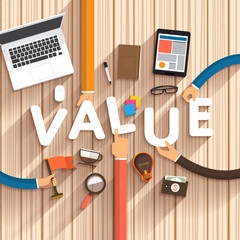“You can have all of this value for an awesome price!”
“Compared to our competition, I’m offering you a really low price”
“We just launched this new product at an outrageously low initial price!”
As part of Advantexe’s work in the area of Strategic Business Selling, we have the opportunity to work with many different types of sales professionals ranging from high-tech sales to managed care pharmaceuticals sales. Recently, I have noticed a disturbing trend where sales professionals have been “adjectifying” price in their conversations with customers. As we all know, price is often a primary driver of decision making for most customers; however, there is something called the value dashboard that a customer uses to make a final decision and the other elements of the value dashboard beyond price play a part in the entire value proposition. Levels of service, product quality, product availability, brand, are just a few of the other possible elements of the value dashboard. The issue here is that by focusing too much on price by placing a strong adjective in front of it, you are separating price even further away from the other elements of the value dashboard which make the full value proposition.
with many different types of sales professionals ranging from high-tech sales to managed care pharmaceuticals sales. Recently, I have noticed a disturbing trend where sales professionals have been “adjectifying” price in their conversations with customers. As we all know, price is often a primary driver of decision making for most customers; however, there is something called the value dashboard that a customer uses to make a final decision and the other elements of the value dashboard beyond price play a part in the entire value proposition. Levels of service, product quality, product availability, brand, are just a few of the other possible elements of the value dashboard. The issue here is that by focusing too much on price by placing a strong adjective in front of it, you are separating price even further away from the other elements of the value dashboard which make the full value proposition.
The core philosophy of our approach toward strategic business selling is to be perceived by the customer as a business professional and not just another sales person acting like a circus barker shouting about your competitive low price. To do that, you must get away from adjectifying the price and position the complete value proposition in ways that:
Impacts your customer’s business challenges and opportunities
Your customer is going to buy something from you if they think the complete value proposition is going to impact their business challenges and opportunities. The job of a great sales professional is to first understand those challenges and opportunities through research and business dialogues and then illustrate how your solution makes a positive impact. Take for example a pharmaceutical Managed Care professional selling to an integrated healthcare system. One of the healthcare systems biggest challenges is re-admissions of patients. Besides not being great for the patient, it’s bad for the hospital because they get penalized from the payer (insurance company) and their Patient Satisfaction and Quality ranking go down. Instead of the pharmaceutical sales professional selling a product on price, he is missing the opportunity to position his quality product as a solution that can reduce re-admissions because of the higher quality profile. In this case, the customer can see that even though the pharmaceutical product may be relatively more expensive than a generic, the long-term impact to the customer’s financial performance - and survival - is significant.
Helps the customer’s customers
Your customer has a customer. The job of a sales professional is to help your direct customer understand that your combination of value will help their direct customer and that process should never include price as price doesn’t make a product better in the value chain. For example, the chemical industry sales professional selling a raw material to a customer who is making an end-product for consumers. In this example, the raw material the sales professional is selling has the ability to interact faster and more effectively with other raw materials making then end-product better and less expensive to make. A better product for the end-customer which is less expensive to make is a much better value proposition to positon than an adjectified price that has less relevance to the end-customer.
Path to the trusted advisor
Every sales professional these days seems to be striving toward the goal of becoming a “trusted business advisor.” But what does that actually mean in 2016 and beyond? For one thing, it does not mean pushing a product based on “outrageously low prices.” It means having the business acumen to understand the real business challenges and opportunities of your customer and developing a professional relationship that is based on mutual respect and a healthy business interchange. For example, the sales professional who sells a high tech solution. There are new competitors entering the market every day and customers can’t keep up with the changes. Inevitably new competitors come along and try to push their product with a competitive price message trying to disrupt and displace the existing vendor. The trusted business advisor understands the customer’s business as well as the customer does and is able to help the customer navigate through challenges and see unseen opportunities. That is a real and significant business process that is based on being a real trusted advisor and it’s a process that should never start with and adjectified price.




